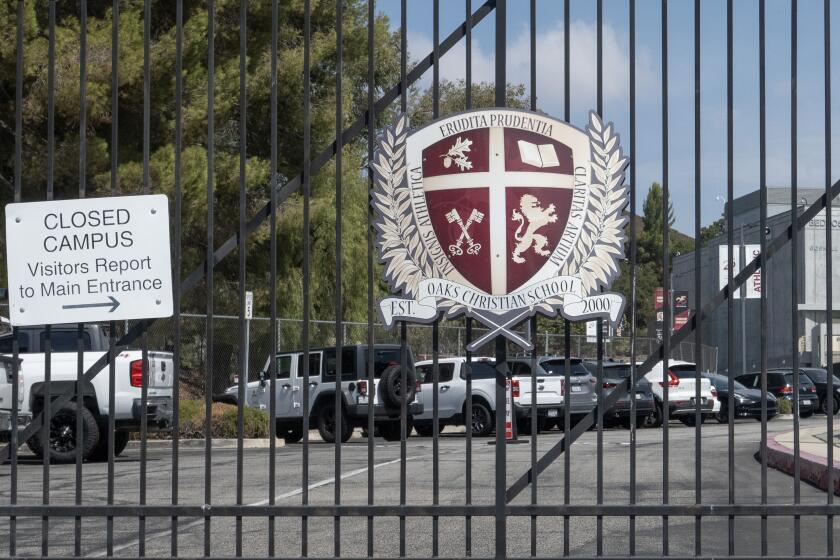Applicants for Amnesty Swamping Classrooms
Officials at Ventura County community colleges and adult education programs say they have been swamped by foreign-born students trying to meet amnesty requirements by taking courses in English and civics.
“There are hundreds of people waiting to enroll in these courses,” said Jose de Paz, community coordinator for El Concilio of Ventura, an umbrella organization for Latino service groups. “There’s just not enough space.”
Students who want either to study for a U.S. Immigration and Naturalization Service proficiency examination or to take courses that substitute for the test face filled classrooms and waiting lists with as many as 500 names.
Immigrants who applied for amnesty at the start of the program in May, 1987, had to wait 18 months before applying for permanent residency. Educators believe that the classroom crunch is being caused by the realization among these people that they only have 12 more months to meet their educational requirements.
‘Every Day More and More’
“We really were caught off guard,” said Jose de la Pena, dean of student affairs at Moorpark College. “We hadn’t realized how enormous a problem it was going to be.”
Moorpark College didn’t even apply for special federal funding for the courses until September. While it received approval last week to offer amnesty classes for 300 students beginning in February, the school’s waiting list now includes 500 applicants, De la Pena said.
Ventura College has increased its amnesty-related course offerings tenfold since September, when school opened with two classes. And while the college is teaching about 600 amnesty applicants in four locations across the county--Ventura, Ojai, Santa Paula and Fillmore--its waiting list includes 440 students and the tide shows no sign of turning, said Jaime Casillas, coordinator of the college’s amnesty program.
“Every day, we get more and more,” said Norma Frisby, an instructional assistant in the program’s satellite campus at the Santa Paula Vocational Center.
Oxnard Union High School District’s Adult School isn’t much better off. Its administrators have managed to whittle down the waiting list of 860 students that it faced 3 months ago by adding a dizzying array of courses. From English as a Second Language to fast-paced American civics courses given in English, the school offers 68 classes that count toward the INS’ educational requirements, said Mike Hernandez, director of Oxnard’s Adult School.
Still, the school has a 654-name waiting list. School counselors call prospective students as soon as openings become available, but some have grown impatient.
“It’s so hot to get into these classes that they say they’ve been called when they really haven’t,” said Ruth Ann McAllister, a counselor at the school.
Oxnard College is in the same boat. More amnesty applicants have been placed on waiting lists--325--than in classrooms--300--at the college, said Carlos Diaz, the college’s facilitator for bilingual programs. Diaz said he would like to add enough courses this spring to teach 750 students, but he fears that he will not be able to hire enough teachers. Despite advertising for openings, the district has been able to find only half of the teachers it needs.
“They have to have proficiency in teaching English as a Second Language, which tends to reduce the applicant pool considerably,” said Roger Boedecker, the college’s acting president.
Some educators blame the overcrowding on the INS and the state Department of Health and Human Services, which administers funding for educational programs aimed at amnesty applicants.
They say the agencies were slow to notify them of the number of students expected and even slower to determine curriculum for the courses. Until 3 weeks ago, for instance, educators understood that applicants would only have to complete 30 hours--not the required 40 hours--of their course work by the time of their final application for permanent residency.
“The INS and Health and Human Services did not realize the magnitude of the problem in many suburban and outlying areas,” said Harry Pachon, director of the Washington-based National Assn. of Latino and Elected Officials. “Since they’re not educational agencies, they didn’t look ahead and say, ‘Hey, another agency’s going to get involved.’ ”
A recent study by the group found that eight out of 10 suburban or outlying cities around Los Angeles--including Oxnard--have not been able to meet the educational needs of amnesty applicants.
The result has been paradoxical, he said. Schools in areas with the greatest numbers of amnesty applicants have experienced far fewer bottlenecks.
“Since they’ve been aware that there might be a problem, they’ve been ahead of the curve,” Pachon said, citing the Los Angeles Unified School District. He said that school district is meeting the demand of 192,000 amnesty applicants through such innovative programs as offering courses 24 hours a day in one school.
By contrast, Ventura County has an estimated 16,500 applicants. But educators are already so far behind that Latino advocates fear that some applicants may not complete their courses within the 30-month deadline, thus losing their chance for legal status and running the risk of deportation.
“There’s a real concern that people aren’t going to be able to meet the educational requirements in time,” Pachon said.
Some educators also worry that the overcrowding will spawn storefront schools that will take advantage of the amnesty applicants by overcharging them or poorly preparing them for the examination.
Mark Hill, chief legalization officer in Oxnard’s INS office, dismissed the concerns as “alarmist.” He said most of the county’s amnesty applicants still have 2 years to meet the requirements.
“A lot can get done in that time,” he said.
As for the delay in notifying schools, he said Congress is to blame--not the INS.
“We didn’t get the requirements for the second phase approved until a couple of weeks ago,” he said. “Until then, we had no idea how it was going to be accomplished.”
Some Latino activists even doubt the merits of the requirement, which has been criticized both for being too detailed in matters of American government and too superficial in English instruction to truly benefit the applicants.
“People are not going to become fluent in English in 40, 80 or even 100 hours,” Jose de Paz said. “We see this as just another obstacle that the INS has put in the way of these people. It’s just another attempt to make some of them fall through the cracks.”
Hill hotly denies the allegation. “We’re doing everything we can to make it simple,” he said, citing plans to open a testing facility in Oxnard. He also said the requirements are more rudimentary than trivial.
“I took the test, and the questions were more like, ‘Where do you mail a letter--at the Post Office or at the INS?’ ” he said. “We’re not requiring that these people be constitutional scholars or masters of the English language.”
More to Read
Sign up for Essential California
The most important California stories and recommendations in your inbox every morning.
You may occasionally receive promotional content from the Los Angeles Times.










